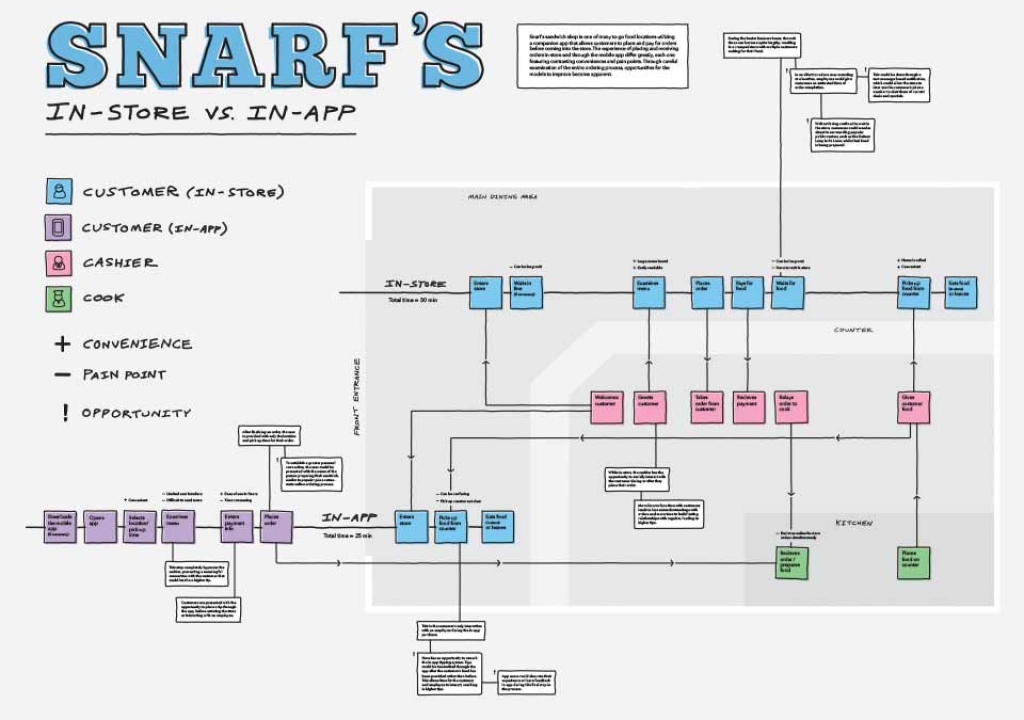In the Spring of 2017 I taught course called Service Design to undergraduate communication design students. The first project was titled “Mapping Experiences” and was intended to introduce student to the idea of using a service design research methods to map an experience while at the same time making a compelling poster project. As artifacts for communication I have observed the landscape of journey maps and service blueprints often feeling complex in part due to how they are created. Post-it notes and scribbles dominate how we make them to begin the process. They are good for getting the ideas out on paper and moving information around. However, taking these posters to another level in which they become tools for organizational understanding and communication can improve their impact and usefulness.
Above are some sample of the student posters by Olivia Alchek, Wade Johnson, Alex Hammarskjold, Lydia Kim, and Kelly Tsao.
Below is the project description.
Mapping Experiences
Overview
A map is a common tool used by many disciplines. Service designers use maps as strategic tools for understanding large complex systems, the objects people use in them, the steps people take through the system and the people that provided services along way. Often these maps capture a variety of emotional and or decision point data that informs what might solve specific or sequences of the challenges or opportunity. Journey maps and blueprints are two methods. Maps are also created to support interaction between a consumer and a service such as to simply guide a person from point A to B. At opposite ends of the spectrum, from strategic overviews to daily tools, each has a different context to address and goals to meet. The process for creating them can also vary in depth and breadth.
For this short project, you will select an experience of your choice to make a map that communicates at multiple levels. It will error on the side of a strategic map, yet with the graphic fidelity that makes it quickly understandable and compelling as a visual. Readings provide a foundation for various types of maps and structures. While many of the examples may be “simple” they offer levels and structures for exploring a service experience that is key in the understanding phase of a project. Your challenge is to select the appropriate visual structure and create a visually compelling map that communicates at multiple levels and suggest potential solutions. The topic should be one you can have quick access to people that can give you insights about the topic area.
Prompts
The following are various prompts; however, you are free to select an experience you are interested in. Do not dwell a great deal on the topic and once you select it you must stick to it.
- Planning for post college life in a place you have never been to.
- Exploring the zoo with five people you sort of know.
- Going to the super market to buy food for a vegetarian party with four friends.
- Thinking about, going to, ordering and eating your favorite food.
- Traveling to the St. Louis Arch and back.
- Navigating the career counseling experience.
- Going to visit a friend at the hospital and navigating various spaces.
- Managing your class registration and course selections over college life.
Readings
- Mapping Experiences by Jim Kalback pg. 1-44
- This is Service Design Thinking by Stickdorn & Schneider pg. 28-51 and 68-87
- Linn Vizard, There’s a Map For That! The Designer’s Cartography of Complexity: https://vimeo.com/190602711
- Phil Robinson, Being Scrappy: Service Design Meet Rapid Growth: https://vimeo.com/190606863
- Touchpoint, Vol 1, No 1: What is Service Design?
- A Guide to Service Blueprinting by Nick Remis and the Adaptive Path Team at Capital One
- Hugh Dubberly & Shelley Evenson, “Designing for Service: Creating an Experience Advantage,” (2010)
- The Difference Between a Product and a Service – As Told With Hammers by Eric Flowers
- The difference between a journey map and a service blueprint by Megan Erin Miller and Erik Flowers
Thanks:
Thank you to Christine Stavridis for helping out with this class. She was a visiting designer, alum of the program, and terrific partner in supporting the content for this new class. The posters in the slides above are from the following students in order of presentation: Olivia Alchek, Wade Johnson, Alex Hammarskjold, Lydia Kim, and Kelly Tsao. These are only a few of the many created.

